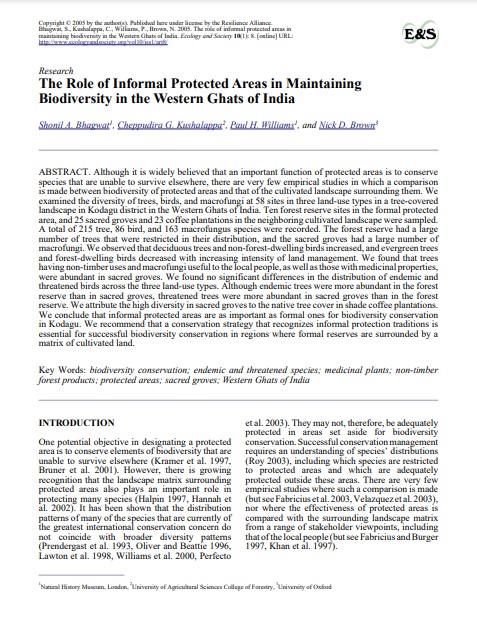The role of informal protected areas in maintaining biodiversity in the Western Ghats of India
Bosque Modelo:
Kodagu
Temática:
Desarrollo humano
Tipo de documento:
Artículo científico
Resumen
Although it is widely believed that an important function of protected areas is to conserve species that are unable to survive elsewhere, there are very few empirical studies in which a comparison is made between biodiversity of protected areas and that of the cultivated landscape surrounding them. We examined the diversity of trees, birds, and macrofungi at 58 sites in three land-use types in a tree-covered landscape in Kodagu district in the Western Ghats of India. Ten forest reserve sites in the formal protected area, and 25 sacred groves and 23 coffee plantations in the neighboring cultivated landscape were sampled. A total of 215 tree, 86 bird, and 163 macrofungus species were recorded. The forest reserve had a large number of trees that were restricted in their distribution, and the sacred groves had a large number of macrofungi. We observed that deciduous trees and non-forest-dwelling birds increased, and evergreen trees and forest-dwelling birds decreased with increasing intensity of land management. We found that trees having non-timber uses and macrofungi useful to the local people, as well as those with medicinal properties, were abundant in sacred groves. We found no significant differences in the distribution of endemic and threatened birds across the three land-use types. Although endemic trees were more abundant in the forest reserve than in sacred groves, threatened trees were more abundant in sacred groves than in the forest reserve. We attribute the high diversity in sacred groves to the native tree cover in shade coffee plantations. We conclude that informal protected areas are as important as formal ones for biodiversity conservation in Kodagu. We recommend that a conservation strategy that recognizes informal protection traditions is essential for successful biodiversity conservation in regions where formal reserves are surrounded by a matrix of cultivated land.
Información Bibliográfica
Autor:
Bhagwat, SA, CG Kushalappa, PH Williams and ND Brown.
Revista:
Ecology and Society
Año:
2005
N°:
1
País :
India
Páginas:
-
Volumen:
10
Idioma:
Ingles
Palabras claves
biodiversity conservation, endemic and threatened species, medicinal plants, non-timber forest products, protected areas, sacred groves, Western Ghats of India





